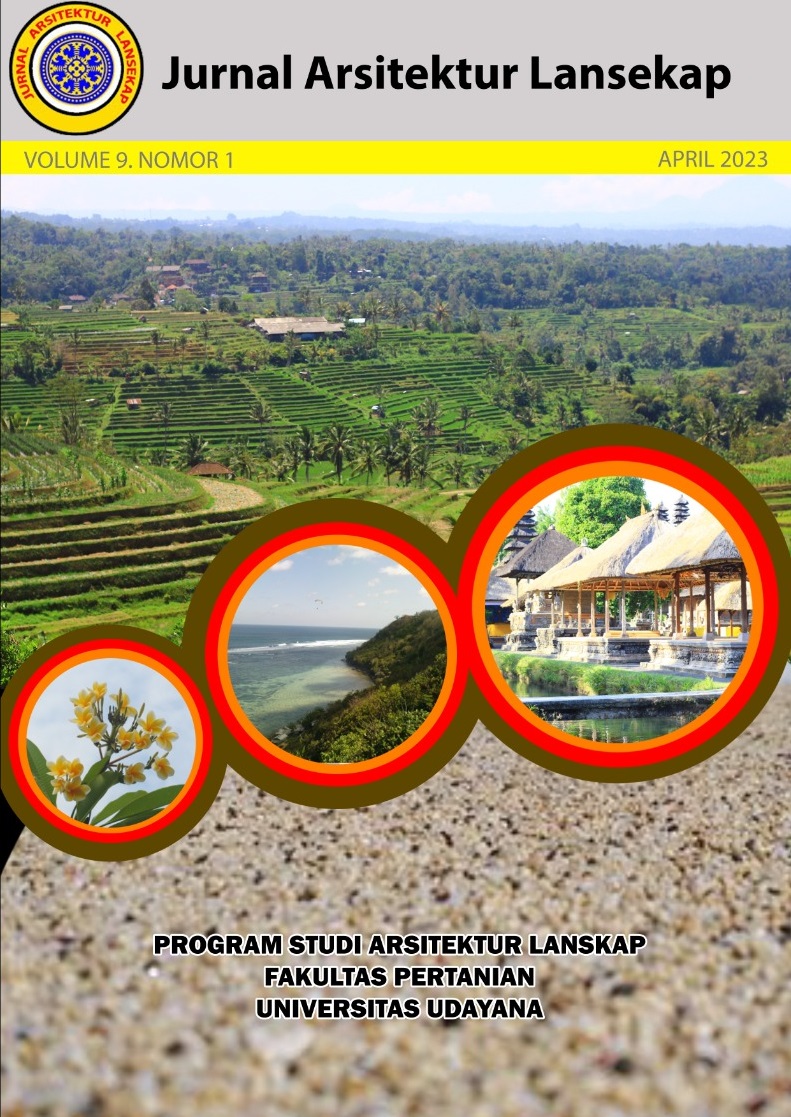Evaluasi Fungsional Dan Estetika Pohon Pada Lanskap Jalan Uluwatu I, Jimbaran
Abstract
Functional and Aesthetic Evaluation of Trees in the Road Landscape of Uluwatu I, Jimbaran Street. Uluwatu I, Jimbaran street must have a road landscape that can provide comfort and create high beauty for
road users to support tourism infrastructure on Uluwatu I, Jimbaran street. Therefore, this study aims to
evaluate the functional and aesthetic value of road landscape trees. The method used is the observation
method. There are two aspects of tree function that are assessed, namely the shade function and the pollution
control function. In the assessment of all aspects of tree function, segment 2 received the highest percentage
of assessment (64.6%). Each function has an average fulfillment of 54.1% for the shading function and 51.5%
for the pollution control function, which is included in the medium category. For aesthetic value, in landscape
photos of similar tree groups there are only two landscape photos that fall into the category of high aesthetic
value, namely landscape photos 3 (segment 1) and landscape photos 7 (segment 4). In the mixed tree group
landscape photo, there is only one landscape photo that is included in the high aesthetic value category, namely landscape photo 8 (segment 4). Therefore, intensive care is needed for young trees, so that tree height, branch height above the ground and maximum canopy shape can reach the ideal value. Adding a layer of plants, also adding tree planting to create a road landscape with high functional and aesthetic value.
Downloads
References
Austin, R. L. (1982). Designing with Plants. Van Nostrand Reinhold Company. Inc. New York. 168p.
Badan Pusat Statistik Provinsi Bali. (2019). Keadaan Meteorologi dan Geofisika Menurut Kabupaten/Kota di Provinsi Bali,2019.Provinsi Bali: Badan Pusat Statistik.
Bensinkita. (2020). Polusi Udara di Bali Makin Mengkhawatirkan. Bensinkita.com. Dakses 10 februari 2021, pada: https://bensinkita.com/polusi-udara-di-bali-makin-mengkhawatirkan/.
Departemen Pekerjaan Umum. (1996). Tata Cara Perencanaan Teknik Lanskap Jalan No : 033/T/BM/1996. Resntra Kemenristekdikti 2015-2019, 02, 53 Halaman.
Hidayat, I. W. (2020). Evaluasi jalur hijau jalan sebagai penyangga lingkungan sekitarnya dan keselamatan pengguna jalan bebas hambatan Jagorawi. Program Pascasarjana. Tesis (tidak dipublikasikan) Institut Pertanian Bogor.
Patra, A. D. (2002). Faktor tanaman dan faktor lingkungan yang mempengaruhi kemampuan tanaman dalam menyerap polutan gas NO2. Program Pascasarjana. Tesis (tidak dipublikasikan) Institut Pertanian Bogor.
Reid, G. W. (1993). From Concept to Form. Van Norstrand Reinhold. New York. 162p.
Rizka, J. (2019). Evaluasi Tata Hijau Jalur Hijau Jalan Kota Pekanbaru. Jurusan Arsitektur Lanskap. Skripsi (tidak dipublikasikan) Institut Pertanian Bogor.
Vitasari, D. (2004). Evaluasi Tata Hijau Jalan Pada Tiga Kawasan Pemukiman Besar di Kabupaten Bogor, Jawa Barat. Jurusan BDP. Skripsi (tidak dipublikasikan) Institut Pertanian Bogor.
Wungkar, M. M. (2005). Evaluasi aspek fungsi dan kualitas estetika arsitektural pohon lanskap jalan Kota Bogor. Program Pascasarjana. Tesis (tidak dipublikasikan) Institut Pertanian Bogor.

This work is licensed under a Creative Commons Attribution-ShareAlike 4.0 International License.
An author who publishes in the Jurnal Arsitektur Lansekap (JAL) agrees to the following terms:
- Author retains the copyright and grants the journal the right of first publication of the work simultaneously licensed under the Creative Commons Attribution-ShareAlike 4.0 License that allows others to share the work with an acknowledgement of the work's authorship and initial publication in this journal
- Author is able to enter into separate, additional contractual arrangements for the non-exclusive distribution of the journal's published version of the work (e.g., post it to an institutional repository or publish it in a book) with the acknowledgement of its initial publication in this journal.
- Author is permitted and encouraged to post his/her work online (e.g., in institutional repositories or on their website) prior to and during the submission process, as it can lead to productive exchanges, as well as earlier and greater citation of the published work (See The Effect of Open Access).
Read more about the Creative Commons Attribution-ShareAlike 4.0 Licence here: https://creativecommons.org/licenses/by-sa/4.0/.







